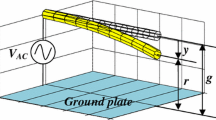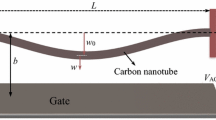Abstract
Two-side accurate analytical estimates of the pull-in parameters of a carbon nanotube switch clamped at one end under electrostatic actuation are provided by considering the proper expressions of the electrostatic force and van der Waals interactions for a carbon nanotube, as well as the contribution of the charge concentration at the free end. According to the Euler–Bernoulli beam theory, the problem is governed by a fourth-order nonlinear boundary value problem. Two-side estimates on the centreline deflection are derived. Then, very accurate lower and upper bounds to the pull-in voltage and deflection are obtained as function of the geometrical and material parameters. The analytical predictions are found to agree remarkably well with the numerical results provided by the shooting method, thus validating the proposed approach. Finally, a simple closed-form relation is proposed for the minimum feasible gap and maximum realizable length for a freestanding CNT cantilever.











Similar content being viewed by others
References
Bogue R (2009) Nanosensors: a review of recent research. Sens Rev 29(4):310–315
Kim P, Lieber CM (1999) Nanotube nanotweezers. Science 286:2148–2150
Akita S, Nakayama Y, Mizooka S, Takano Y, Okawa T, Miyatake Y, Yamanaka S, Tsuji M, Nosaka T (2001) Nanotweezers consisting of carbon nanotubes operating in an atomic force microscope. Appl Phys Lett 79:1691–1693
Dequesnes M, Rotkin SV, Aluru NR (2002) Calculation of pull-in voltages for carbon-nanotube-based nanoelectromechanical switches. Nanotechnol 13:120–131
Wang GW, Zhang Y, Zhao YP, Yang GT (2004) Pull-in instability study of carbon nanotube tweezers under the influence of van der Waals forces. J Micromech Microeng 14:1119–1125
Ouakad HM, Younis MI (2010) Nonlinear dynamics of electrically actuated carbon nanotube resonators. J Comp Nonlinear Dyn 5(1):011009
Bornassi S, Haddadpour H (2017) Nonlocal vibration and pull-in instability analysis of electrostatic carbon-nanotube based NEMS devices. Sens Actuators A Phys 266:185–196
Sedighi HM, Farjam N (2017) A modified model for dynamic instability of CNT based actuators by considering rippling deformation, tip-charge concentration and Casimir attraction. Microsyst Technol 23(6):2175–2191
Mukherjee B, Sen S (2018) Generalized closed form solutions for feasible dimension limit and pull-in characteristics of nanocantilever under the influences of van der Waals and Casimir forces. Mater Res Express 5(4):045028
Farokhi H, Païdoussis MP, Misra AK (2018) Nonlinear behaviour of cantilevered carbon nanotube resonators based on a new nonlinear electrostatic load model. J Sound Vib 419:604–629
Mobki H, Rezazadeh G, Vefaghi A, Moradi MV (2019) Investigation of nonlinear dynamic behavior of a capacitive carbon nano-tube based electromechanical switch considering van der Waals force. Microsyst Technol 25(2):461–475
Fakhrabadi MMS, Khorasani PK, Rastgoo A, Ahmadian MT (2013) Molecular dynamics simulation of pull-in phenomena in carbon nanotubes with Stone–Wales defects. Solid State Commun 157:38–44
Ke CH, Espinosa HD, Pugno N (2005) Numerical analysis of nanotube based NEMS devices—part II: role of finite kinematics, stretching and charge concentrations. J Appl Mech 72(5):726–731
Ke CH, Pugno N, Peng B, Espinosa HD (2005) Experiments and modeling of carbon nanotube-based NEMS devices. J Mech Phys Solids 53(6):1314–1333
Ke CH (2016) Electromechanical properties and applications of Carbon nanotube nanocantilevers. In: Voiculescu I, Zaghloul M (eds) Nanocantilever beams, modeling, fabrication and applications. Pan Stanford Publishing, pp 195–220
Radi E, Bianchi G, di Ruvo L (2017) Upper and lower bounds for the pull-in parameters of a micro- or nanocantilever on a flexible support. Int J Non-Linear Mech 92:176–186
Radi E, Bianchi G, di Ruvo L (2018) Analytical bounds for the electro-mechanical buckling of a compressed nanocantilever. Appl Math Model 59:571–572
Ke CH, Espinosa HD (2005) Nanoelectromechanical systems and modeling. In: Rieth M, Schommers W (eds) Handbook of theoretical and computational nanotechnology, vol 1. American Scientific Publishers, pp 1–38
Ke CH, Espinosa HD (2005) Numerical analysis of nanotube-based NEMS devices—part I: electrostatic charge distribution on multiwalled nanotubes. J Appl Mech 72(5):721–725
Farrokhabadi A, Abadian N, Rach R, Abadyan M (2014) Theoretical modeling of the Casimir force-induced instability in freestanding nanowires with circular cross-section. Phys E Low Dimens Syst Nanostruct 63:67–80
Farrokhabadi A, Abadian N, Kanjouri F, Abadyan M (2014) Casimir force-induced instability in freestanding nanotweezers and nanoactuators made of cylindrical nanowires. Int J Mod Phys B 28(19):1450129
Ouakad HM, Sedighi HM (2016) Rippling effect on the structural response of electrostatically actuated single-walled carbon nanotube based NEMS actuators. Int J Non-Linear Mech 87:97–108
Batra RC, Sears A (2007) Continuum models of multi-walled carbon nanotubes. Int J Solids Struct 44:7577–7596
Koochi A, Kazemi AS, Noghrehabadi A, Yekrangi A, Abadyan M (2011) New approach to model the buckling and stable length of multi walled carbon nanotube probes near graphite sheets. Mater Des 32:2949–2955
Karimipour I, Kanani A, Koochi A, Keivani M, Abadyan M (2015) Modeling the electromechanical behavior and instability threshold of NEMS bridge in electrolyte considering the size dependency and dispersion forces. Phys E 74:140–150
Firouzi B, Zamanian M (2019) The effect of capillary and intermolecular forces on instability of the electrostatically actuated microbeam with T-shaped paddle in the presence of fringing field. Appl Math Model 71:243–268
Espinosa HD, Ke CH (2007) Nanoelectromechanical systems—experiments and modeling. In: Bhushan B, Fuchs H (eds) Applied scanning probe methods VII. Nanoscience and technology. Springer, Berlin, pp 135–196
Mokhtari J, Farrokhabadi A, Rach R, Abadyan M (2015) Theoretical modeling of the effect of Casimir attraction on the electrostatic instability of nanowire-fabricated actuators. Phys E Low Dimens Syst Nanostruct 68:149–158
Sears A, Batra RC (2004) Macro-mechanics properties of carbon nanotubes from molecular mechanics simulations. Phys Rev B 69:235406
Duan J, Li Z, Liu J (2016) Pull-in instability analyses for NEMS actuators with quartic shape approximation. Appl Math Mech 37:303–314
Loh O, Wei XD, Ke CH, Sullivan J, Espinosa HD (2011) Robust Carbon-nanotube-based-electromechanical devices: understanding and eliminating prevalent failure modes using alternative electrode materials. Small 7(1):79–86
Acknowledgements
Support from the Italian “Gruppo Nazionale di Fisica Matematica” INdAM-GNFM is gratefully acknowledged.
Author information
Authors and Affiliations
Corresponding author
Ethics declarations
Conflict of interest
The authors declare that they have no conflict of interest.
Additional information
Publisher's Note
Springer Nature remains neutral with regard to jurisdictional claims in published maps and institutional affiliations.
Appendix
Appendix
The proofs of the two lemmas used in Sect. 3 for obtaining the upper and lower bounds to the CNT deflection are given in the following. These proofs were also given in [16, 17] and are reported here for the sake of convenience.
Lemma A
Let the functionh(x) be continuous up to the third derivative forx ∈ [0, 1] and satisfy the following conditions
and
then
Proof
By using the mean value theorem, from continuity and conditions (51)1,2 it follows that there exists x1 ∈ [0, 1] such that h′(x1) = 0. Then, by using conditions (51)3,4 there exist x2 ∈ [0, x1] and x3 ∈ [x2, 1] such that h′′(x2) = 0 and h′′′(x3) = 0. Since the function h′′′(x) is concave for x ∈ [0, 1] according to (52), it follows that h′′(x) ≤ 0 for x ∈ [x2, 1] and h′′(x) ≥ 0 for x ∈ [0, x2]. Therefore, h′(x) ≥ 0 for x ∈ [0, x1] and h′(x) ≤ 0 for x ∈ [x1, 1]. Since h(0) = h(1) = 0 according to Eq. (51)1,2, then it necessarily follows that h(x) ≥ 0 for x ∈ [0, 1], so that condition (53) holds true. □
Lemma B
Let the functiong(x) be continuous up to the third derivative forx ∈ [0, 1] and satisfy the following conditions
and
then
Proof
By using the mean value theorem, from conditions (54)1,2 it follows that there exists x1 ∈ [0, 1] such that g′(x1) = 0. Moreover, by using conditions (54)3,4 there exists x2 ∈ [0, x1] such that g′′(x2) = 0. Condition (55) then implies that g′′(x) is convex. It follows that g′′(x) ≤ 0 for x ∈ [x2, 1] and g′′(x) ≥ 0 for x ∈ [0, x2], and thus g′(x) ≥ 0 for x ∈ [0, x1] and g′(x) ≤ 0 for x ∈ [x1, 1]. Since g(0) = g(1) = 0 according to conditions (54)1,2, then it necessarily follows that inequality (56) holds true. □
Rights and permissions
About this article
Cite this article
Bianchi, G., Radi, E. Analytical estimates of the pull-in voltage for carbon nanotubes considering tip-charge concentration and intermolecular forces. Meccanica 55, 193–209 (2020). https://doi.org/10.1007/s11012-019-01119-8
Received:
Accepted:
Published:
Issue Date:
DOI: https://doi.org/10.1007/s11012-019-01119-8




